Muay Thai is a way of life for the people of Thailand and is a deep-rooted part of Thai culture. It forms a part of Thai history and is the national sport of Thailand. It involves the use of the fighters’ entire bodies while fighting. Muay Thai became popular internationally between the twentieth and the twenty-first century when practitioners from Thailand began participating in matches outside the country.
Training for Muay Thai begins at a very young age and the fighters must follow a strict routine. Waking up early and training is essential, and everyone must spend hours learning fighting techniques and fitness. Fighters play more than a hundred matches before they can become champions. Muay Thai is a sport that requires commitment and dedication to succeed.

There is a strict dress code that must be followed by fighters during a Muay Thai match. The men are not allowed to keep beards or untidy hair and must always trim their toenails. It is necessary to wear an armband, called a Pra Jiad, and a headband called Mongknon. This practice of wearing an armband and headband began when Thailand was in a constant state of war and the fighters would tear off a piece of cloth off a loved one’s clothes and wear it on their foreheads or their arms as a sign of good luck and ward off evil spirits.
The Mongkhon is usually blessed by a Buddhist monk before every fight, whether the fighters are Buddhists or not.
What Does Muay Thai Mean?
Muay Thai means ‘Thai Boxing’ and is ‘The Art of Eight Limbs’, where the end goal for fighters is to take down the opponent. The legs and arms are used in their entirety, and each body part is treated as a weapon; the hands are swords, shins are the shield and armor, knees and elbows are the axe or hammer. A fight typically lasts for five rounds, with each round going on for three minutes.
What is Muay Thai’s History?
The exact origin of Muay Thai is unknown. In 1767, the Burmese army destroyed all the documents related to the origin of the sport. There are various theories as to how it came into being. One tale describes Muay Thai as being used by the Thai military to protect themselves from their neighbors Cambodia, and Myanmar. Another theory states that as the Thai moved away from China towards the south, they floundered in the occupation of land. This encouraged the development of Muay Thai as a means of protection and survival.
Muay Thai in Thai history was known by various names like Toi Muay, or Muay. In around 1238, the northern city Sukhothai saw its first army creation. Army men were trained as fighters in hand-to-hand combat and how to use their body as a weapon. During those times, weapons were not as readily available, and one had to rely on one’s body strength to win a fight.
Over the years in Thai history, young men started training in camps to become adept at this form of self-defence and started using it as a fitness routine. It became a necessity for men in the royal families to master the skill of Muay Thai to be able to defend their people.
During peaceful times, Muay Thai came to become a sport used for entertainment purposes, where fighters pitched against each other, and the crowd cheered for them. In the nineteenth century, King Chulalongkorn took a personal interest in the sport, and, as a result, it flourished. Since the country was not under attack, its popularity for entertainment purposes surged, for its use as exercise, and learning self-defence.
The king formalized Muay Thai by awarding the fighters during his son’s funeral in 1909. In 1913, the British boxing college Suan Kulap College modified its curriculum to include the increasingly popular sport. In the year 1921, a permanent ring was set up in the college for Muay Thai fights.
In 1923, the first international Muay Thai ring was set up in blue and red with padded corners at the Suan Sanuk Stadium. This ring was commonly used for British boxing and Muay Thai. Between the years 1923 to 1935, King Rama VII insisted on making proper rules for the sport, which were put into effect. Local fighters began fighting at the Lumpinee Boxing Stadium.
It became mandatory to wear modern gloves and groin protectors during Muay Thai matches and training. This ensured better safety standards. Before the gloves were introduced, knots made of ropes were used over knuckles, making it a dangerous tool for the opponent and protecting the fighters’ hands. The death of a fighter in the ring during a Muay Thai match led to the change, and gloves and cotton coverlets over the ankles and the feet were preferred.
As Muay Thai became more and more popular, The International Federation of Muay Thai Amateur was inaugurated in 1993. The federation consists of about 128 countries. In 1995, The Royal Thai Government, in collaboration with the Sports Authority of Thailand, established the largest and oldest professional organization, World Muay Thai Council.
World Muay Thai Federation was formed in the same year in Bangkok by merging two organizations. 2006 saw the inclusion of the sport in The Sport Accord. The sport came to be known as Muaythai instead of Muay Thai as the rules of the Sport Accord required that the sport could not have a country’s name in its name.
Muay Thai saw its name in the International World Games Association in 2014 and participated in The World Games in 2017, Poland, in the official program. The first University World Muay Thai Cup took place in Bangkok in 2015. Today, Muay Thai is a form of exercise and sport practiced in various countries other than Thailand.
How dangerous is Muay Thai?
Muay Thai is a combat sport that involves all the body parts in close contact with the opponent. Naturally, the fights tend to get violent. Fighters get used to routine nose bleeds, blood on their faces, black eyes, etc. While injuries do happen, the referees closely monitor and intervene when things get out of hand. While Muay Thai is not life-threatening, it can cause certain health risks and damages.

Most Muay Thai fighters in Thailand today use it as a form of exercise. In these controlled settings, injuries are rare. Even when they do happen, they are mild and easy to recover from. In short, Muay Thai is relatively dangerous compared to other sports, but what is life without a little risk?
Top Benefits of Muay Thai
A Muay Thai trainee receives the skills from his master, and in return, offers the greatest respect. Fighters also have the utmost respect for their opponent’s master. Honor is something that everyone strives for, win, or lose. Muay Thai provides that honor to the trainee and the trainer.
Muay Thai also offers mental strength since it requires a lot of focus and concentration. It is important to practice mindfulness to achieve greatness in the sport. It also imparts a lot of physical strength to the fighters who must follow a strict fitness routine.
Sometimes, the sport is perceived as the only way a son in the family can earn a decent income in Thailand. Hopes are built upon it. Children with troubled childhoods and broken homes are given refuge in Muay Thai camps. They thrive in a safe and secure environment and can be completely life-changing for such kids.
Muay Thai is also an alternative career choice for those from less privileged backgrounds in Thailand. On average, the fighters make close to 5000THB a month, a decent income for families to survive. Top-level fighters could also earn close to 10000 THB, which is about $320.
Muay Thai serves as an alternative source of income by way of gambling. It is the only legal gambling allowed in Thailand, apart from lottery tickets. Many fighters earn their bread and butter with gambling money. If sport or gambling discontinued, many people would lose their jobs.
Muay Thai is a sport that makes one humble. Not only does it teaches meaning and values in an individual, but it also instills compassion, self-control, respect, determination, dedication, and hard work.
Is Muay Thai good for self-defence?
Yes, Muay Thai is very good for self-defence. It is a sport that turns the fighters’ bodies into dangerous weapons. With no weapon or tool on you, you can tackle your opponent anywhere and take them by surprise.

Muay Thai also makes you physically stronger. This comes in very handy when handling a weak opponent. The use of the eight limbs helps you hit the other person wherever you want. If the attacker is armed, techniques of the sport enable you first to disarm your enemy and then defend yourself. You can use punches, elbow strikes, knee strikes, and long kicks to defeat the other person.
But in the modern world, where people practice Muay Thai for fitness purposes, they do not have a sense of the real fighting world. They have usually never been in a ring, fighting a real opponent. This may not equip them well enough to tackle a stranger in times of danger.
Where are Muay Thai arenas in Bangkok?
Muay Thai is an integral part of Thai culture and Thai history. Bangkok, Thailand, has no dearth of Muay Thai arenas. No matter where you are in the city, you will find some arena close by to entertain yourself with a match. The busiest and the most visited arena is the Lumpinee Boxing stadium. You can catch a fight every Tuesday, Friday, and Saturday.
Another stadium to visit to watch Muay Thai is Rajadamnerm Stadium, constructed in 1945. The place opens at 6 p.m. in the evenings and hosts a fight on Mondays, Wednesdays, Thursdays, and Sundays. The tickets cost anywhere between 1000 THB to 2000 THB depending on the seats that you pick.
Om Noi Stadium is another popular arena in Bangkok, Thailand for Muay Thai. Also known as the Siam Boxing Stadium, it hosts a fight every Saturday, which is broadcasted live on “Channel 3” of Thai TV. It was opened in 1984 to compete with the bigger Lumpinee and Rajadamnerm stadiums.
You can head to the Channel 7 Boxing Stadium to watch a Muay Thai fight for free. But the matches take place only once a week, on Sunday afternoons and the third Wednesday of every month.
